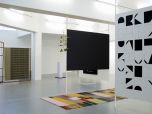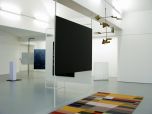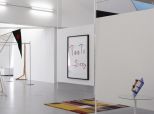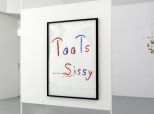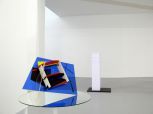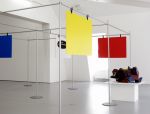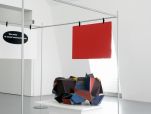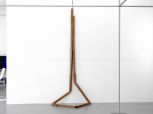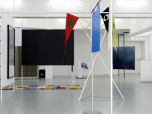|
<< zurück
Martin Beck | Christoph Bruckner | David Jourdan
Jacob Dahl Jürgensen | Pernille Kapper Williams | Marika Lõoke & Jüri Okas
Camilla Løw | Kenneth Martin | Silke Otto-Knapp
Giles Round | Nora Schultz | plus einer Eingabe von Paul Klee.
Idealismusstudio
Koproduktion steirischer Herbst
Ausstellungsdauer / Duration of the exhibition
04. Oktober bis 20. Dezember 2008 / Oktober 4 until December 20, 2008
(for english version please scroll down)
Die Konstruktion des Lebens liegt im Augenblick weit mehr in der Gewalt von Fakten als von Überzeugungen. Wir interessieren uns in diesem Studio ausschließlich für Gegenstände, die uns Impulse dafür geben, wie die Wirklichkeit aussehen könnte, nicht wie sie erscheint. Dass Ideale in der wirklichen Welt sich nicht darstellen lassen, wissen wir; wir behaupten nur, dass nach ihnen die Wirklichkeit beurteilt und von denen, die dazu Kraft in sich fühlen, modifiziert werden müsse. Wir betrachten Materie als eine Erscheinungsform des Geistes, akzeptieren das objektiv Wirkliche lediglich als Idee. Die empirischen Erscheinungen zählen für uns nur als Verweis auf das Wahre-Sein. Wir erkennen ein Ding nicht an, wie es uns als Gegenstand unserer Wahrnehmung erscheint — eingekleidet in die Anschauungsformen von Raum und Zeit —
— eingebettet in die Kategorien von Anwendung und Funktion — wie es an sich beschaffen ist, werden wir niemals erkennen. Für uns unterscheidet sich die Wirklichkeit von der Realität dadurch, dass sie auch das Mögliche enthält. Wirklichkeit wollen wir sowohl im Gegensatz zum bloß Scheinbaren als auch zum bloß Möglichen verstehen.
Im Studio
Eine Proben-Situation.
Unsicherheit und Entschlossenheit zugleich bestimmen diese Szenerie.
Arbeiten (alphabetisch)
expandable, portable, viewable, 2006 (Version Grazer Kunstverein 2008)
Aluminiumröhren, -steher und Kunststofftafeln (teilweise siebgedruckt)
Skulptur basierend auf einem Ausstellungssystem namens Struc-Tube, das der US-amerikanische Designer George Nelson 1948 für eine Grußkartenfirma entwickelte. Das System kann ohne Werkzeuge oder spezielle Kenntnisse auf- und abgebaut werden und ist innerhalb eines quadratischen Rasters endlos erweiterbar. Nelsons System wurzelt im modernistischen Glauben an das emanzipatorische Potenzial der Ausstellung als Kommunikationsformat; wohingegen dessen geometrische Rationalität die tayloristische Sprache des modernen Kapitalismus spricht.
Beck setzt die von ihm durchgeführte originalgetreue Rekonstruktion auf drei Ebenen ein: als Skulptur (wie hier im Kunstverein), als Mietsystem unter dem Titel Struc-Tube und als „Akteur“ in einem Film mit dem Titel About the Relative Size of Things in the Universe. Im Kunstverein wurden die Module von Beck so zusammengesetzt, dass vier quadratische Sektionen einen symmetrisch aufgeteilten Raum ergeben. Die Konstruktion verweist nicht zuletzt auf die Experimente mit gitterartigen Raumstrukturen Sol LeWitts oder auf die an industrieller Serialität und geometrischer Reduktion ausgelegten „Primary Structures“ der Minimal-Art.
Beck gebraucht das Medium Ausstellung in seiner künstlerischen Praxis als ein Format, das die Verbindung kritischer Recherchen mit ästhetischer Kommunikation ermöglicht. Die Appropriation der Struc-Tube bedeutet auch die Auseinandersetzung mit den Zusammenhängen von Display, Autorität und der Herstellung sozialer Realität. (lebt in New York)
Studie zu Das Kapital öffentlicher Raum 2007, 2007
Flüssigkreide-Marker auf Tafellack auf Spanplatte, 135 x 100 cm
Die Rekonstruktion einer Wandtafel, die der Künstler Joseph Beuys (1921 bis 1986) als Teil der Arbeit Das Kapital Raum 1970-1977 gezeigt hat. Das Original misst 162 x 120 cm. Der vielschichtige Werkkomplex Das Kapital Raum ist eine Konzentration von Arbeiten aus unterschiedlichen Jahren und wurde 1984 als raumgreifende Installation zusammen mit den dafür eingerichteten Hallen für neue Kunst in Schaffhausen eröffnet. Das Kapital Raum gilt als Vermächtnis von Beuys. Für seine Rekonstruktion hat sich Bruckner dem Studium der Handschrift von Beuys detailliert gewidmet (sowie der anderen Handschriften, die sich auf der Tafel identifizieren lassen, da sie im dialogischen Prozess mit anderen – Kollegen und/oder Publikum – entstand).
Composition abstrait spatial, 2008
Kunstdrucke, Karton, Kleister, Leim, Holz, Superkleber, 42 x 91 x 75 cm
Eine Skulptur aus Segmenten von Kunstdrucken von Bildern des Malers Serge Poliakoff (1900 bis 1969). Poliakoff findet – stark beeinflusst von Wassily Kandinsky und Otto Freundlich – zu seiner eigenen Ausprägung abstrakter Malerei, in der er bunte Farbflächen unregelmäßig nebeneinander stellt. Bruckner hat aus mehreren Kunstdrucken eine Skulptur gemacht, die als mögliche Verräumlichung der Arbeit Poliakoffs gelesen werden kann. (lebt in Wien)
o.T., 2008
Siebdruck auf Papier, 110 x 150
In einer Reihe von Siebdrucken hat David Jourdan den Schriftzug eines Graffitis mehrfach freigestellt und nachgedruckt, das er auf dem Cover des Buches “The Faith of Graffiti” gefunden hat. Das Buch wurde 1974 veröffentlicht, bevor Film, Hip-Hop und andere Medien die neue urbane Kunstform bekannt gemacht hatten. Es bildet den damaligen Stand der frühen New Yorker Graffitikultur ab. Der Essay von Norman Mailer positioniert Graffiti vs. Werbung, vs. Autorität und nicht zuletzt vs. Kunst. Jourdan setzt sich in seinen Arbeiten immer wieder mit der Verbildlichung von Sprache auseinander und mit den Verschiebungen der Bedeutung von Texten und Objekten. Schrift, Übersetzung, Herausgeberschaft oder wie bei Toots Sissy ein Verfahren der mechanischen Reproduktion (inklusive seiner produktionsbedingten Differenzen) sind Methoden, die er auf die Quellen und Dokumente, die ihn interessieren, wiederholt anwendet: Zu dieser Arbeit schreibt er: „… For once, here is text which is not addressing its reader but only claiming loud its own existence, cryptic by essence, with its coded syntax and lexicon. Look! Only it will lOOk back at you." (lebt in Wien)
The Order, 2008 (Rekonstruktion)
Holzprofile, Stoff, Kette und Metallwinkel, 155 x 140 x 235 cm
Eine Skulptur, die auf drei diagonal verlaufenden, sich in der Mitte überkreuzenden Holzprofilen basiert. Es ergeben sich die Volumen 2 dreiseitiger Pyramiden, von denen das eine umgekehrt auf der Spitze des anderen zu stehen scheint. Während die Struktur am Boden durch eine lose Kette zusammengehalten wird, ist sie am oberen Ende durch drei horizontal angebrachte Holzprofile stabilisiert, an deren überstehenden Enden jeweils eine von Dahl Jürgensen selbst genähte Fahne befestigt ist.
In dieser Arbeit interessiert sich Dahl Jürgensen für eine Beobachtung, dass die Ikonografie sowohl des Konstruktivismus als auch des Futurismus teilweise religiöse oder okkulte Symbolismen instrumentalisiert. Auf der formalen Ebene schafft die Arbeit Zusammenhänge zwischen visionären und archaischen Aspekten avantgardistisch-revolutionärer Ästhetik (der ersten Hälfte des 20. Jahrhunderts). (lebt in London)
579m2 or 0,061m3 or 1m Pile of Unwritten Writings, 2005.
White paper, 21 x 29,7 x 100 cm und MDF, 50 x 62 x 0,22 cm
Eine nicht definierte Anzahl von Blättern herkömmlichen Kopier- bzw. Druckerpapiers ist auf die Höhe eines Meters gestapelt. Die Kanten schließen einheitlich ab, so dass ein aufrechter Kubus entsteht, der zugleich Assoziationen an einen leeren Sockel im Raum der Ausstellung aufruft. Der Stapel ist auf einer rechteckigen schwarzen MDF Platte positioniert, die am Boden liegt. (lebt in Brüssel)
Modell für suprematistischen Blumenkiosk (est. Suprematistlik lillelett Piritale), 1985
Plexiglas, Kunststoff, Sperrholz, Farbe, Aufkleber, Spiegel, 30 x 24 x 46 cm (Spiegeldurchmesser = 55 cm)
Das Modell bewegt sich auf dem Grad zwischen abstrakter Skulptur und konkret dem Gestaltungsvorschlag für einen Blumenkiosk für eine Messe. Im Sinne suprematistischer Ästhetik baut die Arbeit formal auf einfachen geometrischen Formen und Grundfarben auf. Zugleich zeugt sie von einer Denkweise, die versucht, sich das Potenzial einer von Gegenstandsbezügen befreiten Kunst zu vergegenwärtigen und dieses zugleich im Kontext der Gestaltung urbaner Umwelt konstruktiv zu erproben. In der UdSSR hatte das Format des Kiosks durch die Revolution und durch Künstler wie zum Beispiel Gustav Klucis oder Alexander Rodchenko eine Rolle als Mittel der Information und Propaganda bekommen. Insofern ließ und lässt sich der Entwurf von Looke & Okas aus den 80er Jahren auch als eine Reflexion sozialistischer Alltagsrealität lesen. Marika Looke & Jüri Okas gehören einer Generation von Architekten an, den es in den 70er und 80er Jahren in Tallinn (damals UdSSR) um eine aktive Teilhabe an der Gestaltung gesellschaftlicher Realität ging. Insofern nahm diese Generation einerseits Bezug auf die konstruktive Rolle der Künste in der Gesellschaft, wendete sich aber andererseits von dem ab, was unter dem Label „offizielle“ Kunst produziert wurde. (leben in Tallinn)
Viva, 2004
Holz, Schnur, 245 x 90 x 70 cm
Eine Gruppe von unterschiedlich langen aber einheitlich flächigen Holzkuben, die von den Stirnseiten her durchlöchert und auf eine Schnur aufgezogen sind. Die Schnur ist so an der Wand befestigt, dass die aufgefädelten Holzkuben zu etwa zwei Dritteln auf den Boden hinab fallen, wo sie eine Schlaufe bildend zum Liegen kommen. Vom Konstruktionsprinzip erinnert das Stück an ein handgefertigtes Halsband, wohingegen die Materialen und Verarbeitung Assoziationen an skandinavisches Möbeldesign zulassen. Mit der weich fallenden Schnur und den sperrigen Hölzern instrumentalisiert Viva sowohl die gegensätzlichen stofflichen Qualitäten der Materialien als auch den Widerspruch von Hängend und Liegend als Form-Bildende Prinzipien in Viva. (lebt in Oslo)
Nine Variations, 1966
Messing, 48 x 38 x 33 cm
Martins mobile Drahtplastiken und hängende Metallkonstruktionen beruhen auf mathematischen Logiken, mit denen sich der Künstler zunehmend auseinander gesetzt hat, nachdem er erst ab den 40er Jahren zur geometrischen Abstraktion gefunden hat. Zusammen mit der Künstlerin Mary Martin und dem Künstler Victor Pasmore steht er für einen britischen Nachkriegskonstruktivismus. Trotz ihres formal ungegenständlichen Charakters hat Martin seine Kunst nicht autonom verstanden, sondern die Arbeiten als Module innerhalb eines gesellschaftlichen Systems gesehen, deren „Vorschläge“ und Überlegungen in Austausch mit anderen Bereichen dieses Systems stehen. Dieser Ansatz ist in Zusammenhang mit der Arbeit von KünstlerInnen wie El Lissitzky oder Katarzyna Kobro zu sehen. Der konstruktive Ansatz dieser Kunst begründet sich dadurch, die formale Organisation von Raum zugleich als Arbeit an den gesellschaftlichen Möglichkeiten zu begreifen. (1905 – 1984, England)
Two Figures (Airplane), 2008
Aquarell und Gouache auf Leinwand, 85 x 100 cm
Malerei, die eine Szene aus der Aufführung des Balletts Romeo et Juliette adaptiert, das Bronislava Nijinska (1892 bis 1972) in Anlehnung an die gleichnamige Tragödie 1926 in Paris choreografiert hat. Von 1914 bis 1921 lebte Nijinska in Russland, wo sie ab 1919 ihre eigene Schule für Bewegung gründete. Während der Zeit im revolutionären Russland entwickelte sie ein vom Formvokabular des Konstruktivismus beeinflusstes Ballett, gekennzeichnet durch starke Abstraktion, mechanistische Bewegungen, asymmetrische Komposition und dem Bruch mit der klassischen Hierarchie zwischen Individuum (Solo) und Kollektiv (Gruppe) im klassischen Ballett.
Otto-Knapp’s Malerei bezieht sich auf die Szene, in der Romeo und Julia durchbrennen, wobei sie die latent futuristische Figur eines Flugzeugs bilden. Das Bild orientiert sich relativ präzise an den historisch dokumentierten Bewegungen der TänzerInnen und am Verhältnis zwischen den Körpern und den von ihnen evozierten Formen. Dabei eignet sich Otto-Knapp diese unter den Bedingungen und Möglichkeiten von Malerei neu an, so, dass es zu einer Art Re-Choreografie im Raum der Bildfläche kommt. Der tatsächliche Bühnenraum und die historisch dokumentierte Ausstattung oder Kleidung werden dagegen in den Bildern unterschiedlich stark verändert, reduziert, gelöscht oder durch andere Motive ausgetauscht.
Group (Pool), 2008
Aquarell und Gouache auf Leinwand, 130 x 150 cm
Ebenfalls Adaption einer Szene eines von Bronislawa Nijinska (s.o.) choreografierten Balletts; „La Valse“ ist ein choreographisches Gedicht in einem Akt, für das Maurice Ravel die Musik geschrieben hat und das von Ida Rubinstein und Anatol Vilzak getanzt wurde. Obwohl die Uraufführung erst 1929 stattfand, geht die Entstehung auf die Jahre 1919 und 1920 zurück. Eine private „Uraufführung“ gab es mit Maurice Ravel und Marcelle Meyer am Klavier im Salon von Misia Sert bereits im April 1920 in Anwesenheit von Sergej Diaghilev, Igor Stravinsky und Francis Poulenc. (lebt in London)
Display Structure with Textile, 2008
Mahagoni, Edelstahl, Leinen, Siebdruck, 100 x 210 x 207 cm
Ein quadratischer und ein rechteckiger Holzrahmen sind ineinander geschoben und über ein senkrechtes Drehgelenk so miteinander verbunden, dass die beiden Rahmen in verschiedenen Winkeln zueinander zum Stehen gebracht werden können. Das senkrecht stehende Teil ist mittels zweier Horizontalen in drei Felder unterteilt. Dagegen ist über die obere Verbindung des quadratischen Teils ein Stück bedrucktes Leinen gelegt, dass auf beiden Seiten bis knapp über den Boden herab fällt. Die Konstruktion kann sowohl zur Präsentation von Textilien dienen als auch als Wandschirm oder Paravent; eine zusammenlegbare und überall aufstellbare Wand, die zur Präsentation, Organisation und Sichttrennung in Innenräumen dient. Die Struktur reflektiert Gestaltungsanliegen der Moderne zu Beginn des zwanzigsten Jahrhunderts und bezieht sich auf den Zusammenhang von Architektur, Design und der Frage nach dem besseren Leben. Das von Round für das Leinen entworfene Muster steht in Zusammenhang mit seiner Produktion von Schriftbildern und ist darauf angelegt, fortlaufend druckbar und flexibel anwendbar zu sein.
Pre Font, 2006
Wandmalerei, Bleistift, Pigmentfarbe, Farbe, 165 x 207 cm
Die von Round entworfene Pre Font basiert auf der Rasterung eines senkrecht stehenden Rechtecks in vier Felder mittels eines auf dem Kopf gedrehten Kreuzes. Alle rund und eckig verlaufenden Winkel sind an den Endpunkten mit einer Geraden verbunden. Die so entstehenden Binnenflächen sind ausgemalt. (lebt in London)
Countdown Table, 200x
Edelstahl, bedrucktes Papier, 100 x 96 x 20 cm
Ein quadratischer Stahlrahmen, dessen horizontale Verbindungen in eine leichte Kurvenform gebogen sind, grade so, dass die Konstruktion aufgestellt werden kann. An der Oberkante ist ein Stück bedrucktes Offset Papier befestigt, Durch senkrechte Einschnitte fächert sich der am Boden aufliegende Abschnitt des Blattes in Form des Rahmens auf. Die Zahlen bezeichnen einen Countdown. (lebt in Berlin)
Teppich, handgewebt, 160 x 340 cm, 1929/2008
Ausgangspunkt für den Teppich ist das 1929 entstandene Aquarell "Monument im Fruchtland" (auf deutschem Ingres auf Karton, 45.7 x 30.8 cm, Courtesy: Zentrum Paul Klee Bern) das Klee‘s Auseinandersetzung mit den Beziehungen zwischen Linie, Fläche und Farbe im Bildraum zeigt. Klee lehrte von 1920 bis 1931 am Bauhaus. Seine Kurse, u.a. in der Gestaltungslehre für die Weberei, hatten direkten Einfluss auf das Formenvokabular der textilen Produktion des Bauhauses; vgl. z.B. Arbeiten von Greten Neter-Kähler, oder den Gobelin von Ruth Hollós-Consemüller. Klee selbst hat keine funktionalen Textilien produziert. Obwohl "Funktion" auch in der Weberei zu den Schlagwörtern des Bauhauses gehörte, blieb lange die ästhetische Orientierung dominant, die der geforderten Nutzfunktion im Wege stand: Kontraste zwischen dicken und dünnen, zwischen matten und glänzenden Fäden waren oft ästhetisch bedingt und für eine funktional ausgerichtete Produktion hinderlich. Mit der Devise „Volksbedarf statt Luxusbedarf“ spitzte sich der Streit zwischen den „angewandten“ und den „freien“ Künstlern zwischen 1928 und 1931 so zu, dass Klee das Bauhaus verließ. Die Aneignung von Klee's Aquarell im Format des Teppichs ist der Versuch, sich die Bedeutung des nicht nur Bauhaus-spezifischen Problems der Kompatibilität zwischen künstlerischer und gesellschaftlicher sowie handwerklicher und industrieller Produktion zu vergegenwärtigen. (1879 Schweiz - 1933 Emigration aus Deutschland - bis 1940, Schweiz.)
(english version)
The construction of life at the moment lies far more in the power of facts than of convictions. In this studio we are solely interested in objects that act as impulses for the way reality could look, not how it does appear! We know that ideals cannot be represented in the real world; we merely maintain that reality should be judged in their light and modified by those who sense the power within themselves to do so. We view matter as a mental manifestation, accept the objectively real solely as an idea. For us empirical manifestations are mere pointers to True-Being. We do not acknowledge a thing in the way it appears as an object to our perceptions — clothed in the intuited forms of space and time — embedded in the categories of application and function — we shall never know how it is actually constituted. For us actuality distinguishes itself from reality in that it contains the possible. We want to grasp the actual in contrast to the merely apparent, as well as to the merely possible.
Im Studio
A rehearsal situation.
Setting determined by uncertainty and resolve in equal measure.
Works (in alphabetical order)
expandable, portable, viewable, 2006 (Version for Graz Kunstverein 2008)
Aluminum pipes and stayers; plastic panels (in some cases silkscreened)
Sculpture based on an exhibition system called Struc-Tube, which the American designer George Nelson developed in 1948 for a greeting card company. The system can be assembled and dismantled without any tools or special know-how and can be infinitely expanded within a square grid. Nelson’s system has its roots in the Modernist belief in the emancipatory potential of exhibition as a communication form, whereby its geometric rationality speaks the Taylorist language of modern capitalism.
Beck sets up his reconstruction on three different levels: as sculpture (such as here in the Kunstverein), as a rental system entitled Struc-Tube, and as an “actor” in a film called About the Relative Size of Things in the Universe. Beck’s modular at the Kunstverein is constructed in such a way that the four square sections create a symmetrically partitioned space. The construction not least refers to Sol LeWitt’s experiments with latticed spatial structures, as well as to the industrial serialism and geometric reduction of the Minimal Art Primary Structures.
Beck uses the medium ‘exhibition’ in his artistic practices as a format that permits a connection between critical investigations and aesthetic communication. The appropriation of the Struc-Tube also signifies the analysis of the associations between display, authority and the construction of social reality. (lives in New York)
Studie zu Das Kapital öffentlicher Raum 2007 (Study on Capital Public Space 2007), 2007
Liquid chalk marker on wood varnish on chipboard, 135 x 100 cm
A reconstruction of a chalkboard the artist Joseph Beuys (1921 - 1986) presented as part of his work Das Kapital Raum 1970-1977. The original piece is 162 x 120 cm. The multilayered aggregate work, Das Kapital Raum, is a concentration of works made in various years and was presented for the first time in 1984 as a space-encompassing installation in the Hallen für neue Kunst in Schaffhausen. Das Kapital Raum is regarded as one of Beuys' legacies. As part of the work’s reconstruction Bruckner devoted himself to the study of Beuys’s handwriting. (The artist also studied the other handwritings on the board that could be identified since it was created in a dialogical process with colleagues and/or the public.)
Composition abstrait spatial, 2008
Art prints, cardboard, paste, glue, wood, Super Glue, 42 x 91 x 75 cm
A sculpture of segments of art prints of paintings by the painter, Serge Poliakoff (1900 - 1969). Poliakoff’s abstract painting – strongly influenced by Wassily Kandinsky and Otto Freundlich – takes form through irregularly adjoining colored shapes. Bruckner made a sculpture out of numerous art printings that can be regarded as a possible spatialisation of Poliakoff’s work. (lives in Vienna)
o.T. (Untitled), 2008
Silkscreen print on paper, 110 x 150 cm
In a series of silkscreen prints David Jourdan repeatedly extracted the writing of a piece of graffiti that he found on the cover of the book, “The Faith of Graffiti,” and reprinted it. The book was published in 1974 before film, Hip-Hop and other media made this new urban art form famous. The book portrays the state of early New Yorker graffiti culture. Norman Mailer’s essay positioned graffiti vs. advertising, vs. authority and, not least, vs. art. In his works Jourdan repeatedly analyzes the visualization of language and the displacement of the meaning of texts and objects. Writings, translations, publishing or, as in the case of Toots Sissy, the process of mechanical reproduction (including its production-specific nuances) are methods that Jourdan repeatedly applies to sources and documents that interest him. (lives in Vienna)
The Order, 2008 (Reconstruction)
Wood sections, cloth, chain and metal braces, 155 x 140 x 235 cm
A sculpture that rests on three diagonal wood sections, which intersect in the middle. The volumes of two three-sided pyramids appear, one of which seems to lie upside down on the top point of the other. Whereas the structure is held together on the floor by means of loosely connected chains, it is stabilized on its upper end by means of three horizontally mounted wood sections, at the projecting ends of which hangs a flag sewn by Dahl Jürgensen himself.
With this work, Dahl Jürgensen observes that the iconography of both Constructivism and Futurism at times instrumentalise religious and occult symbolisms. On a formal level the work establishes connections between visionary and archaic aspects of avant-guarde-revolutionary aesthetics from the first half of the 20th century. (lives in London)
579m2 or 0,061m3 or 1m Pile of Unwritten Writings, 2005.
White paper, 21 x 29,7 x 100 cm and MDF, 50 x 62 x 0,22 cm
An undefined number of sheets of ordinary copy and printing paper are stacked in a meter-high pile. The edges are uniform, creating an upright cuboid that also brings to mind the idea of an empty pedestal in the exhibition space. The stack is placed on a rectangular black MDF board on the floor. (lives in Brussels)
Suprematistlik lillelett Piritale (Model for Suprematic Flower Kiosk), 1985
Plexiglas, plastic, plywood, paint, stickers, mirror, 30 x 24 x 46 cm (mirror diameter = 55 cm)
The model is situated somewhere between an abstract sculpture and a concrete design proposal for a flower kiosk at a trade fair. In the sense of a suprematic aesthetic the work is built up with simple geometric forms and primary colours. At the same time it testifies to a manner of thinking that attempts to visualize the potential of an art that is free of references to objects, and, at the same time, to constructively test this in the context of the shaping of an urban environment. In the USSR, the kiosks played a great part as agents of information and propaganda, due to the revolution and the works of artists like Gustav Klucis and Alexander Rodchenko. From this point of view the design by Looke & Okas from the 1980s can also be seen as a reflection of everyday socialistic reality. Marika Looke & Jüri Okas belong to a generation of architects who was concerned with the active participation in shaping social reality in the 1970s and 80s in Tallinn (then part of the USSR). This generation thus, on the one hand, referred to the constructive role of the arts in society while, on the other hand, it turned its back on art that was produced and regarded as “official.” (live in Tallinn)
Viva, 2004
Wood, cord, 245 x 90 x 70 cm
A group of wood cuboids of different lengths, but of uniform surface, are perforated on both sides and hoisted on a cord. The cord is fixed to the wall in such a way that approximately two thirds of the wood cuboids beaded on to it rest on the floor where they lie in a loop. The principle of the work’s construction reminds one of a handmade necklace, whereby the materials and manufacturing arouse associations with Scandinavian furniture design. With the gently falling cord and the bulky wood elements Viva instrumentalizes both the opposing material qualities, and the contradiction, between the states of hanging and lying as the form creating principles in Viva. (lives in Glasgow)
Nine Variations, 1966
Brass, 48 x 38 x 33 cm
Martin’s movable wire sculptures and hanging metal structures are based on mathematical logic that the artist increasingly explored after finding his way to geometric abstraction in the 1940s. Together with the artists Mary Martin and Victor Pasmore, he represents post-war British Constructivism. Despite the formal non-representational character of his works, Martin did not regard them as autonomous, but rather as modules within a social system whose suggestions and reflections existed in dialogue with other parts of this system. Such an approach should be viewed in connection with the work of artists such as El Lissitzky and Katarzyna Kobro. The constructivist approach of this art can be characterized through an understanding of the formal organisation of space also as a consideration for social possibilities. (1905 – 1984, England)
Two Figures (Airplane), 2008
Watercolour and gouache on canvas, 85 x 100 cm
A painting that adapts a scene from the performance of the ballet Romeo et Juliette that Bronislava Nijinska (1892 - 1972) choreographed in 1926 in Paris according to the tragedy of the same name. Nijinska lived from 1914 to 1921 in Russia, where she founded her own school of movement. During the revolutionary period in Russia she developed a type of ballet that was influenced by Constructivist form vocabulary and was marked by severe abstraction, mechanical movements, asymmetrical composition and a break with the traditional hierarchy between the individual (solo) and the collective (group) of classical ballet.
Otto-Knapp’s painting refers to the scene in which Romeo and Juliette run away, whereby they form the latent Futuristic figure of an airplane. The painting closely refers to the historically documented movements of the dancers and on the relationship between the bodies and the forms they evoke. In doing this Otto-Knapp appropriated both within the conditions and possibilities of painting so that she creates a kind of re-choreography in the dual space of the image. The actual stage area and the historically documented sets and costumes are, by contrast, altered, reduced and erased to varying degrees or exchanged with other motives.
Group (Pool), 2008
Watercolour and gouache on canvas, 130 x 150 cm
Also an adaption of a scene from a ballet choreographed by Bronislawa Nijinska (see above); "La Valse" is a chorographical poem in one act for which Maurice Ravel wrote the music and which was danced by Ida Rubinstein and Anatol Vilzak. Although the premiere took place in 1929, the work’s origins date back to 1919 and 1920. A private premiere was performed with Maurice Ravel and Marcelle Meyer on the piano in Misia Sert’s salon in April 1920 in the presence of Sergej Diaghilev, Igor Stravinsky and Francis Poulenc. (lives in London)
Display Structure with Textile, 2008
Mahogany, stainless steel, linen, silk screen print, 100 x 210 x 207 cm
A square and a rectangular wooden frame are pushed together and are connected to a pivot joint in such a way that the two frames can be brought to a standstill at different angles to each other. The vertical standing part is divided into three fields by means of two horizontal ones. In contrast, on top of the upper connection of the square part lies a piece of printed linen that hangs down on both sides, ending just above the floor. The construction can serve both for the presentation of fabric and as a folding screen or room divider; a foldable wall, which can be set up anywhere and can be used for presentation, organization and as a visual shield in interior spaces. The structure reflects design preoccupations of the Modern movement at the beginning of the 1920s and refers to the connection between architecture, design and the question of a better life. The pattern Round designed for the linen is related to his production of fonts (see below) and is intended to be consecutively printable and used flexibly.
Pre Font, 2006
Mural painting, pencil, pigment paint, paint, 165 x 207 cm
The Pre Font designed by Round is based on the rasterisation of a vertical standing rectangle into four segments using an upside down cross. All round and angular angles are connected at their ends with a straight line. The ensuing inside spaces are painted. (lives in London)
Countdown Table, 2007
Stainless steel, printed paper, 100 x 96 x 20 cm
A square steel frame, whose horizontal joints are bent into a slight arch so that the construction can be erected. Fixed to the upper edge is a piece of printed offset paper. By means of perpendicular cuts, the portion of the paper resting on the floor fans out in the form of the frame. The numbers on it designate a countdown. (lives in Berlin)
Rug, hand woven, 160 x 340 cm, 1929/2008
The rug is based on the watercolour Monument im Fruchtland painted by Paul Klee in 1929 (on German Ingres paper on cardboard, 45.7 x 30.8 cm, courtesy Zentrum Paul Klee Bern), which displays Klee’s analysis of the relationship between, line, plane and colour in the picture space. (cont. next page)
Klee taught from 1920 to 1931 at the Bauhaus. His courses, including a design class for the weaving workshop, had a direct influence on the form vocabulary of the Bauhaus’ textile production; compare, for instance, works by Greten Neter-Kähler and the Gobelin tapestry designed by Ruth Hollós-Consemüller. Klee did not make any functional textiles himself.
Although “function" was also a Bauhaus slogan in the weaving workshop, an aesthetic orientation dominated for a long time and stood in the way of the usefulness the school demanded: contrasts between thick and thin, matt and shiny threads were often conditional on aesthetics and obstructive to a functional-oriented production. With the motto ‘the needs of the people instead of the needs of luxury,’ the dispute between the “applied” and the “fine” artists became so intense from1928 to 1931 that Klee left the Bauhaus. The appropriation of Klee‘s watercolour as a rug is the attempt to visualize the significance of the compatibility between artistic and social, manual and industrial production, a problem that is not just specific to the Bauhaus. (1879 Switzerland - 1933 emigration from Germany to 1940, Switzerland)
Monitor
The film Bambule, which was produced by the journalist, Ulrike Meinhof, and Eberhard Itzenplitz is presented on the exhibition’s monitor. It was scheduled to be broadcast for the first time on 24 May 1970. Meinhof went underground before the film’s completion, leaving Itzenplitz to complete the editing and technical production alone. Bambule explores the situation of young women in state supervised homes. Meinhof analyses these institutions with regard to their disciplinary function and as an instrument of class creation. All scenes are extremely stylised at a formal level and exactly choreographed. The screenplay is the resulting collaboration of Meinhof, Itzenplitz and Heimmädchen, who, at times, appear in the film as actors. Bambule is a document that depicts the exact point of intersection between Meinhof’s socio-political work and her militant action. Heinrich Böll caught the attention of the police at the time, in part because of the following comment he made regarding the film: “Have people ever considered the fact that the members of the group surrounding Ulrike Meinhof have performed practical social work and thereby have examined the conditions that may have led them to make their declaration of war?” Length: 90 min. Color:b/w
Kurator / curator
Søren Grammel
<< zurück
|


